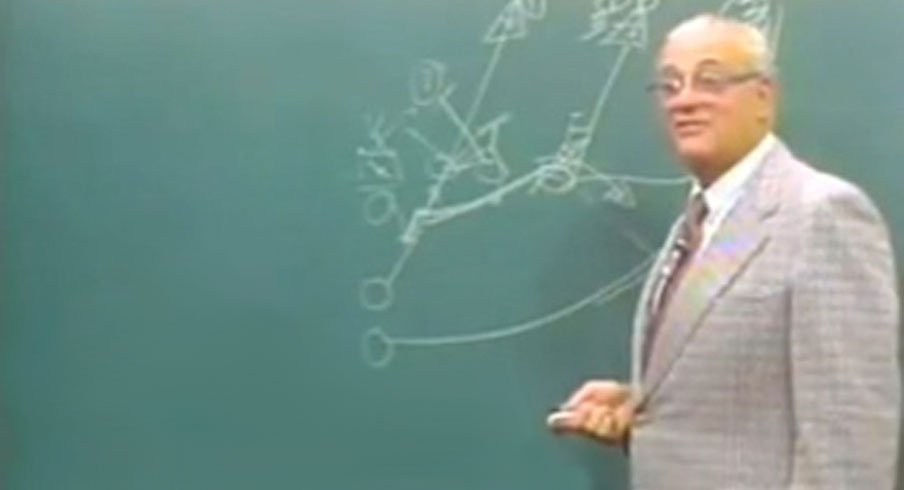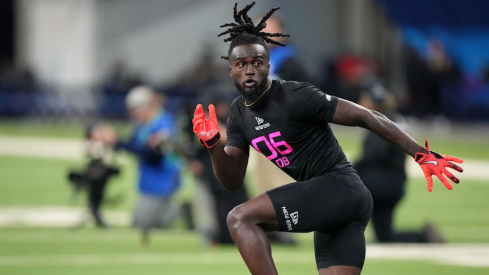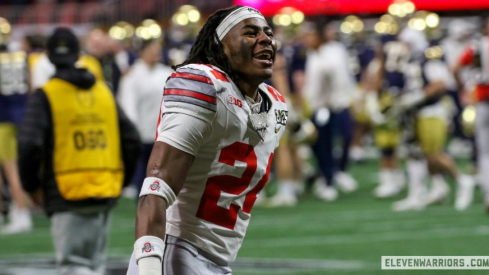So if Chris Ash's job is to properly install cover 4 as the base Ohio State defense, what will it look like?
Ash begins his implementation of the coverage by starting with quarters' purpose, along with its strengths and weaknesses.

Ash's then works to utilize cover 4 in a way that allows his defense to benefit from the coverage strengths while minimizing the weaknesses. To do so, he deploys four primary calls within cover 4: Four; Cathy; Cleo and Cloud. Each call is made by the secondary based upon how the offense aligns.
Four
Four is the base call against a pro-style formation; i.e. one with 21 (2 RB, 2 WR, 1 TE) or 12 (1 RB, 2 WR, 2 TE) personnel.

With Four, the corner plays what amounts to a loose man to man. To take away the quick passing game, the corner can play press coverage and use a bail technique, quickly getting depth post-snap.
The safety sits flat-footed at 10 yards and reads the No. 2 (inside receiver) to his side of the field. The safety and outside linebacker work in tandem coverage based upon what the No. 2 receiver does.
If the inside receiver releases vertically, the safety takes him in man and the outside linebacker quickly gets outside depth to defend curl to flat. If the inside receiver release outside within five yards, the outside linebacker will cover him in man coverage and the safety will play his quarter zone and looks to help on the outside receiver. If the No. 2 receiver crosses inside, the safety and outside linebacker passes him off to the inside linebackers and play their deep fourth and flat zones, respectively.

The combination coverage rules demonstrate the mixed nature of cover 4. It is a matchup zone that requires extensive amounts of man coverage from the back seven defenders, but also pattern matching and proper communication.
Cathy
Cathy is utilized by Ash against spread formations, namely when an offense has two or more detached receivers to one side. Ash describes it as a "soft pattern read."
With Cathy, it is the corner and safety that work in tandem to read the release of the No. 2 receiver to their side:
- Outside Release < five yards -- Corner takes the flat; safety works over the top of the outside receiver, and OLB drops to hook to curl;
- Inside Release -- The corner takes the outside receiver in man while the safety plays his zone and looks to bracket the outside receiver;
- Vertical Release -- Corner and safety take No. 1 and 2 in man coverage.
The corner and safety also have rules for the specific combination patterns of china and scissors.
- China (aka Smash) -- The corner sinks to help the safety with the corner route while the OLB (or nickel) quickly extends to the smash route.
- Scissors -- The corner and safety trade off the crossing receivers.
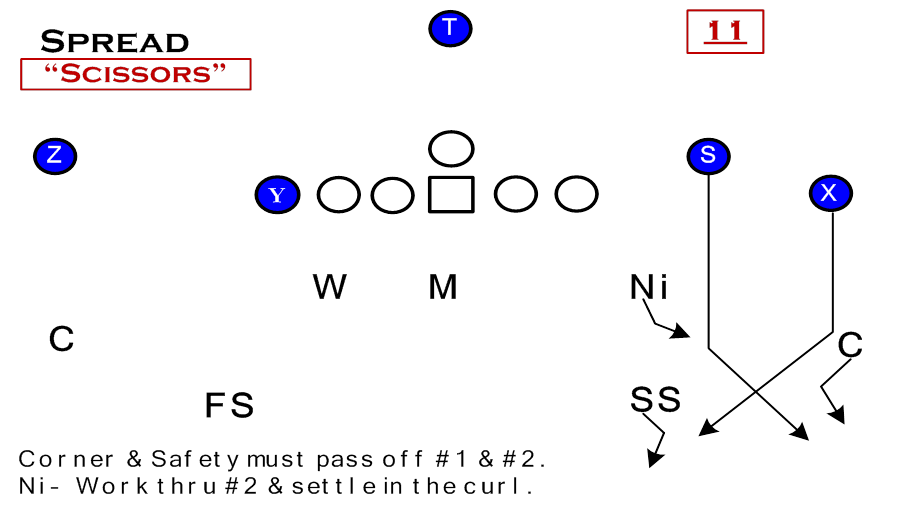
In sum, the corner, safety and outside linebacker work in combination to play man coverage against distributed patterns within their zone, taking care to be aware of particular route combinations that are used against cover 4.
Cleo
A Cleo call is made between the safety and corner when the offense has two detached wide receivers with a minus split or stacked alignment.
Cleo is not necessarily an independent concept. Instead it is a version of Cathy with one adjustment. The difference between Cleo and Cathy is that the corner and safety use an in and out concept where they will pass off the inside and outside receivers regardless of depth.
Again, the goal is to respond to methods offenses use to attack cover 4. Offensive coordinators look to confuse cover 4 defensive back reads by having receivers switch or cross. Offenses tend to do so from such stack alignments. Cleo is a preemptive measure to more easily have the corner and safety trade off receivers that cross their zones.
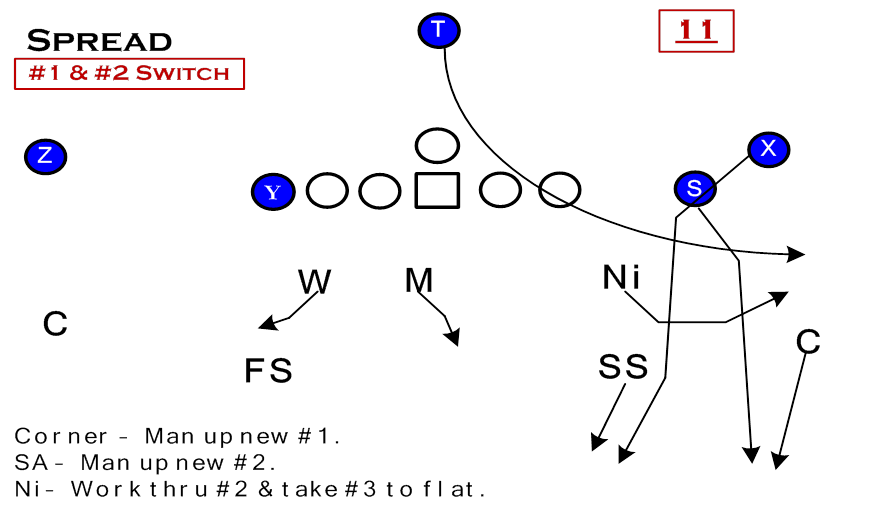
Cloud
Cloud is the final tag Ash uses with Cover 4. Cloud is actually an amalgamation of cover 2 and cover 4. With cloud, the outside linebacker or nickel -- and not the safety -- will cover the No. 2 receiver with man coverage if he releases vertically. The safety then plays a deep half zone.
Cloud is used against 2 x 2 shotgun formations away from the offset halfback to avoid giving the offense an easy flat route completion to the No. 3 receiver.
Cloud is a change-up, preventing an offense from assuming the safety will cover the number 2 route vertically without deep help. With cloud, the defense will now have a receiver playing man underneath the receiver with the safety robbing over the top, providing the potential to create turnovers through confusion.
Mix and Match
The coverage calls are not separate concepts but can be used in tandem. The corner, safety and outside linebacker to each side of the centerline work as a unit independent of their counterparts to the other side. Each side uses the call that responds to what the offense presents to their side of the field.
For instance, if the offense aligns in the shotgun with 11 personnel (3 WR, 1 TE, 1 RB) the defense will play Four to the tight end side and Cathy to the detached 2 WR side.
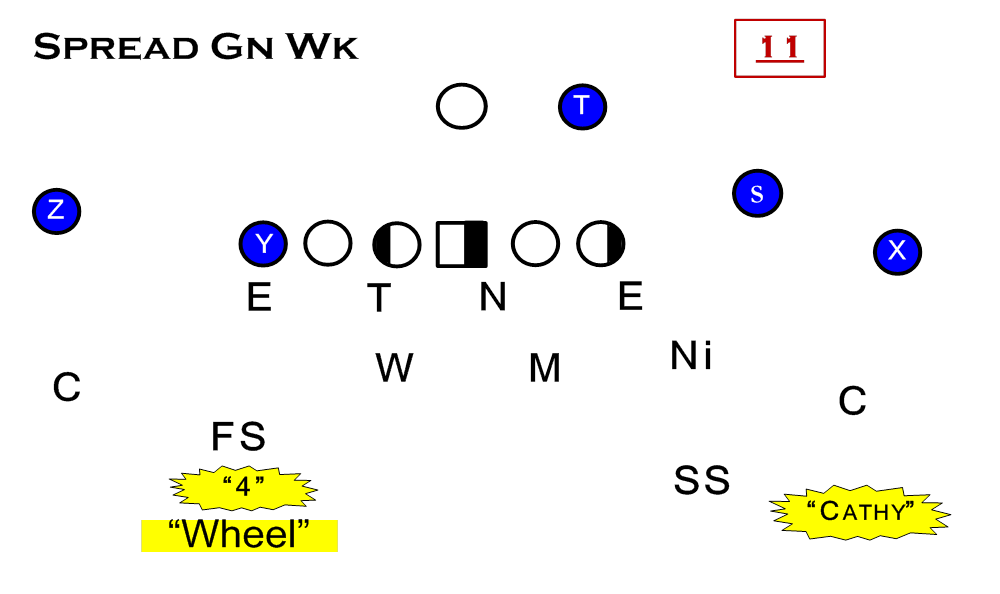
This allows the defense to best defend what the offense is most likely to attempt within a given alignment.
Again, Ash's coverage tags work towards the same purpose. As discussed, Cover 4 allows a defense to easily apply safeties against the run while deploying a match-up zone that utilizes ample amounts of man coverage. But like any defense, Cover 4 also has its weaknesses. Ash's coverage tags are a recognition of those weaknesses and an attempt to minimize them by flexibly adapting to what is presented by the offense.
